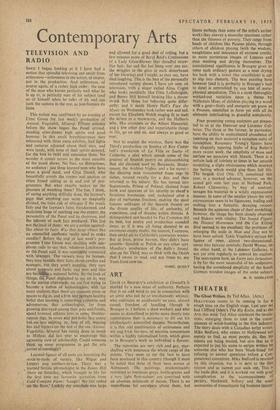Louts LE BROCOUY's exhibition at Gimpel's is marked by a
new sense of authority, Perhaps that is an odd word to use in connection with an artist who can he so unashamedly whimsy, who cultivates so assiduously an easy, almost casual, freedom of handling (though le Brocquy is. I believe. a slow worker), and who seems so disinclined to probe more deeply into appearances than is necessary to fill out his intellectually controlled designs. Nevertheless. it is this odd combination of seriousness and wit and Irish fey-floss. of emotive conceptions within a highly rationalised form, which gives to le Brocquy's work so individual a flavour. The tapestries are very rich and gay, mar- shalling with assurance the whole range of the palette. They seem to me the hest to have been produced in this country (though it must be noted that three of them 'were woven at Aubusson). The paintings, predominantly restricted to luminous greyS, bottle-greens and a very light flesh-colour, are contrived with an absolute minimum of means. There is no superfluous fat anywhere about them, but (more perhaps than some of the artist's earlier work) they convey a muscular spareness rather than the thinness of poverty. They range from heads of children, like Picasso plates, through others of children playing (with the wisdom, naughtiness and innocence of extreme youth). to more portentous images of Lazarus and men washing and drying themselves. The associational significance le Brocquy gives to some such ordinary gesture as a man drying his back with a towel (the crucifixion) is apt to slip into rhetoric. The best painting here however (and it is probably le Brocquy's best to date) is untroubled by any hint of meta- physical speculation. This is a most thoroughly worked-out variation upon a theme by Nicholaes Macs, of children playing in a wood with a goat—lively and energetic yet grave as a Poussin, simplified in form yet with all its elements interlocking in graceful complexity.
Four promising young sculptors are presen- ted to us at the Hanover and Leicester Gal- leries. The three at the former, in particular, have the ability in sophisticated abundance of imposing on their material a complete unity of conception. Rosemary Young's figures have the elegantly tapering limbs of Reg Butler's more recent work, the simplicity of mass and surface we associate with Manzh. There is a certain lack of subtlety at times in her smooth modelling, a slight obviousness which destroys the feeling which would give them full life. The largish Girl (No. 17), completed this year, is a marked advance, however, on the seated girl seen last year in Holland Park. Robert Clatworthy, by way of contrast. savages his material in a wildly expressionist manner, In some of the smaller pieces the very excrescences seem to be liquescent, boiling and melting into a fantastic, decaying rococo. Beneath the apparent chaos of their modelling, however, the image has been closely observed and flickers with vitality. The Seated Figure. the Draped Horseman and the Cat Killing Bird seemed to me excellent; the problems of enlarging the scale in Man and Dog not to have been solved. Takis Vassilak is stylises his figures of open, almost two-dimensional, metal into heiratic symbols; David Wynne, on the other hand, at the Leicester Galleries, is not yet able regularly to control his realism. The centrepiece here, an Entry into Jerusalem, is by far the most successful of his sculptures. having the considered simplicity of the South German wooden' images of the same subject.
M. II. MIDDLETON










































 Previous page
Previous page